#web3 applications
Explore tagged Tumblr posts
Text

Join the Web3 Revolution! With a market cap of $27.5B and counting, Web3 crypto networks are reshaping the digital landscape. Don't miss out on the future of technology!
Know more - https://bit.ly/42sPq8c
2 notes
·
View notes
Text
The latest Web 3.0 technologies, including blockchain, cryptocurrency, & NFTs, have revolutionized the software development industry by focusing on transparency & decentralization.
#Web3 applications#Web3 technology#Web3 vs Web2 in software development#decentralized software development#evolution of Web3#future-proofing software with Web3 technologies
1 note
·
View note
Text
What programming language is used for Web3 Application?
Web3 applications interact with the Ethereum blockchain and other decentralized networks. The primary programming language used for developing Web3 applications is JavaScript. Web3.js is the most commonly used library for building Web3 applications in JavaScript. It allows developers to interact with the Ethereum blockchain through its JSON-RPC API and smart contracts, enabling the creation of decentralized applications (DApps) that can read and write data on the blockchain, execute smart contracts, and interact with users.
Apart from JavaScript, there are other programming languages and libraries that can be used to build Web3 applications. Some of them include:
Python: Python developers can use libraries like Web3.py to interact with Ethereum and build Web3 applications.
Solidity: While Solidity is primarily used for writing smart contracts, some parts of a Web3 application, like contract deployment and interaction, may also involve using Solidity alongside JavaScript.
Go: Golang developers can use libraries like go-ethereum to interact with Ethereum and build Web3 applications.
However, JavaScript remains the most popular and widely used programming language for Web3 development due to its versatility, ease of use, and popularity of the Web3.js library.
Aspiring to learn about web3 application development? Enroll now in the web3 developer course!
0 notes
Text
How Does SwiftUI Enhance App Development in 2024

In 2024, SwiftUI continues to revolutionize iOS app development, offering developers powerful tools and features that enhance productivity and user experience. With its declarative syntax and seamless integration with Swift, SwiftUI is poised to become the standard for building modern applications across Apple’s ecosystem. Here are some key advancements and benefits that make SwiftUI an essential framework for developers this year. 1. Declarative Syntax for Simplified Development
SwiftUI’s declarative syntax allows developers to define user interfaces by simply stating what they want the UI to do, rather than how to implement it. This approach minimizes boilerplate code, making it easier to read and maintain. As a result, developers can focus on creating engaging features without getting bogged down by complex implementation details.
2. Live Preview Features
One of the standout features of SwiftUI is its integration with Xcode, which includes live previews. This functionality allows developers to see real-time changes as they code, significantly speeding up the development process. Gone are the days of compiling and running the entire application to view changes; now, adjustments can be made on-the-fly, enhancing efficiency and collaboration between design and development teams.
3. Cross-Platform Capabilities
SwiftUI enables developers to build applications that run seamlessly across all Apple platforms—iOS, macOS, watchOS, and tvOS—using a single codebase. This cross-platform capability not only saves time but also ensures a consistent user experience across devices. As Apple expands its hardware lineup, the ability to create adaptable applications becomes increasingly valuable.
4. Enhanced Accessibility Features
With a growing emphasis on inclusivity, SwiftUI offers built-in accessibility features that make it easier to develop apps usable by a broader audience. Automatic support for VoiceOver, Dynamic Type, and color contrast adjustments ensures that apps meet modern accessibility standards right out of the box.
5. Improved Animation Capabilities
SwiftUI simplifies the creation of animations and transitions between different UI states. Developers can animate almost any property of a view with minimal code, resulting in visually appealing applications that enhance user engagement. The framework automatically handles the underlying mechanics of animations, allowing developers to focus on crafting delightful experiences.
6. Better Interoperability with UIKit
For existing projects built with UIKit, SwiftUI offers unmatched interoperability. Developers can easily integrate SwiftUI views into their UIKit applications using protocols like UIViewRepresentable and UIViewControllerRepresentable. This flexibility allows teams to adopt SwiftUI gradually while still leveraging their existing codebases.
Conclusion
In summary, SwiftUI is not just a trend but a transformative framework that enhances iOS app development in 2024. Its declarative syntax, live preview capabilities, cross-platform support, enhanced accessibility features, improved animation capabilities, and interoperability with UIKit make it an invaluable tool for developers seeking to create high-quality applications efficiently. As businesses continue to embrace digital transformation, mastering SwiftUI will be crucial for staying competitive in the evolving app landscape.
To explore how Performix can help you leverage SwiftUI for your next project, visit Performix today! Set up a Free Discovery Call
#web3 ios app development#ios swift app development#ios development company#ios development services#ios applications
0 notes
Text
Blockchain is Re-shaping the World: Revolutionizing Industries through Decentralization

Discover how blockchain technology is reshaping industries through decentralization. Explore the latest trends in blockchain for 2024, including finance, healthcare, and supply chain. Learn how CDN Solutions Group leads the way with innovative blockchain development services, dApps, and Web3 solutions. Visit us at Gitex Global 2024 for a firsthand look at our blockchain innovations. Visit now to read more: Blockchain is Re-shaping the World: Revolutionizing Industries through Decentralization
#blockchain technology#blockchain trends#blockchain#blockchain networks#blockchain partner#blockchain development expertise#blockchain development services#blockchain development#blockchain solutions#blockchain innovation#web3 solutions#decentralized technologies#blockchain experts#blockchain tech#blockchain services#decentralized applications#dapps#blockchain in finance#blockchain in healthcare#blockchain in supply chain#blockchain for real estate#blockchain revolution
0 notes
Text
Digital Currencies in 2024: The Future of Money and Technology

Description
Digital currencies, often referred to as cryptocurrencies, have revolutionized the financial landscape. As we move into 2024, their influence continues to expand, reshaping everything from international trade to individual financial empowerment. In this article, we’ll explore the evolution of digital currencies, highlight their most prominent features, and delve into the future trends that could shape the world of finance
Understanding Digital Currencies
Digital currencies are decentralized, internet-based forms of money that use cryptographic technology to ensure secure, peer-to-peer transactions. Unlike traditional fiat currencies controlled by central banks, cryptocurrencies such as Bitcoin, Ethereum, and Ripple (XRP) operate on blockchain technology—a transparent ledger that records all transactions.
The Rise of Bitcoin and Altcoins
Bitcoin, introduced in 2009, is the first and most widely known cryptocurrency, often dubbed “digital gold.” Over the years, Bitcoin has grown in both value and adoption, serving as a store of value and an investment vehicle.
Other digital currencies, called altcoins, have emerged to challenge Bitcoin's dominance. Ethereum, for instance, introduced smart contracts that automate processes and revolutionized decentralized applications (DApps). In 2024, DeFi (Decentralized Finance) and NFTs (Non-Fungible Tokens), primarily built on Ethereum, continue to attract attention, reshaping the way digital assets are traded and owned
"Unlock your next big opportunity—click the link now and take the first step toward success!"
Top Benefits of Digital Currencies
Digital currencies offer several advantages over traditional financial systems, making them an appealing choice for both investors and everyday users.
Decentralization: Cryptocurrencies are not controlled by any government or financial institution. This ensures users have full control over their assets and are not subject to centralized authorities.
Security: Blockchain technology makes it extremely difficult to alter transaction records, providing a high level of security against fraud and hacking.
Low Transaction Costs: Traditional cross-border payments often involve high fees, especially for international transfers. Cryptocurrencies offer much lower transaction fees, making them attractive for global transactions.
Financial Inclusion: Digital currencies provide access to financial services for people without access to traditional banking. In 2024, millions of unbanked individuals globally are benefiting from using digital wallets and decentralized platforms.
The Most Popular Cryptocurrencies in 2024
In addition to Bitcoin and Ethereum, several other cryptocurrencies are making waves in 2024, including:
Ripple (XRP): Known for its efficient cross-border payment solutions.
Cardano (ADA): Gaining popularity due to its focus on sustainability and scalability in blockchain technology.
Solana (SOL): A fast, scalable platform for decentralized apps and crypto services.
Polygon (MATIC): Enhancing Ethereum’s scalability and enabling cheaper transactions
"Unlock your next big opportunity - click the link now and take the first step towards success!"
The Role of Central Bank Digital Currencies (CBDCs)
Another significant trend in 2024 is the rise of Central Bank Digital Currencies (CBDCs). Unlike decentralized cryptocurrencies, CBDCs are issued and regulated by central banks. Governments across the globe are now exploring their own digital currencies to improve financial efficiency, transparency, and inclusivity. Countries like China with its Digital Yuan, and the European Union with the Digital Euro, have made substantial progress.
CBDCs aim to combine the benefits of cryptocurrency—such as faster, cheaper transactions—with the security and stability of traditional fiat currencies.
Key Trends for Digital Currencies in 2024
As digital currencies continue to evolve, here are some of the key trends shaping their future:
Mass Adoption: In 2024, businesses and institutions worldwide are increasingly accepting cryptocurrencies as a legitimate form of payment, with more retailers integrating crypto-payment solutions.
Web3 and Decentralized Apps (DApps): With the growth of Web3, digital currencies are playing a crucial role in decentralized applications, creating new ways for users to interact with the internet, without intermediaries.
Regulation: Governments are paying more attention to regulating cryptocurrencies, ensuring consumer protection while promoting innovation in the space.
Sustainability Initiatives: The environmental impact of cryptocurrency mining has been a concern, but newer cryptocurrencies like Cardano and Solana are making strides in energy-efficient blockchain solutions
"Unlock your next big opportunity - click the link now and take the first step towards success!"
The Future of Digital Currencies
Looking ahead, digital currencies are likely to continue their upward trajectory, integrating further into everyday life. We can expect advancements in privacy coins like Monero (XMR), which prioritize user anonymity, and growth in interoperability between different blockchain platforms.
Another development to watch in 2024 is the expansion of tokenization, where real-world assets like real estate, stocks, and commodities are being digitized and traded on blockchain platforms.
Investing in Cryptocurrencies in 2024
For investors, digital currencies offer both opportunities and risks. The cryptocurrency market is known for its volatility, but long-term believers view it as a hedge against inflation and a chance to participate in the future of finance. Experts advise diversifying one’s portfolio, researching projects carefully, and staying informed about regulatory changes.
Conclusion
Digital currencies are more than just a trend—they represent a fundamental shift in how we perceive and use money. As we move through 2024, the continued development of blockchain technology, increased adoption of cryptocurrencies, and the integration of digital assets into financial systems will shape the future of the global economy.
For those looking to stay ahead, understanding the potential of digital currencies, exploring opportunities for investment, and adapting to this fast-evolving world are key steps to navigating the new financial landscape
"Unlock your next big opportunity - click the link now and take the first step towards success!"
#cryptocurrency#bitcoin#Ethereum#Blockchain technology#Decentralized finance (DeFi)#Central Bank Digital Currency (CBDC)#Digital wallet#Smart contracts#altcoins#tokenization#web3#DeFi applications#nfts#Crypto regulation#Cryptocurrency exchange
0 notes
Text
New York Venture Summit 2024: Blockchain & Web3 conference

About Event Join us at NYVS 2024, hosted by Young Startup, on September 4–5, New York City, to dive into the future of blockchain and Web3 technologies. This cutting-edge event brings together blockchain enthusiasts, Web3 innovators, and industry leaders to explore transformative advancements in decentralized technologies. Engage in insightful discussions on the impact of blockchain and Web3 on various industries, attend hands-on workshops, and witness demonstrations of the latest innovations. Network with key players driving the evolution of decentralized applications and smart contracts. Don’t miss this opportunity to connect with pioneers and gain valuable insights into the blockchain and Web3 revolution.
To Know More- crypto events in New York
#New York Venture Summit 2024#New York Venture Summit news#web3 conferences New York#Blockchain technologies#Decentralized technologies#Blockchain event 2024#Web3 technologies conference#Blockchain applications#Web3 technology
0 notes
Text
iProgrammer's Web Application Development Services
Unlock the potential of your business with iProgrammer’s Web Application Development Services, our custom web applications are designed to meet your unique requirements, integrating seamlessly with existing systems to ensure smooth data flow and enhanced interoperability. With a focus on security, scalability, and user experience, our tailored solutions adapt to your evolving needs. Partner with iProgrammer and benefit from our expertise and innovative approach, delivering high-performance applications on time and within budget.
For More information, Click here - https://www.iprogrammer.com/web-application-development-services/
#web application development services#web app development#web app developers#web app development companies#web app development agency#offshore web development#web app development services#custom web application#web application development companies#custom application development companies#custom web app development#web3 app development#web application agency#web application development agency#web based app development#custom web app development services
0 notes
Text
Why Web 3 in IoT is the Digital Evolution?
Web 3 in IoT epitomizes digital evolution, converging IoT devices with decentralized web technologies. This fusion enhances connectivity, security, and interoperability, fostering a dynamic ecosystem where devices exchange data autonomously and execute smart contracts. Blockchain integration ensures data integrity and privacy, enabling trustless interactions among devices and users. Decentralized governance and incentivization mechanisms spur innovation, resilience, and inclusivity, propelling us toward a future where interconnected devices drive unprecedented efficiency and convenience in everyday life.
#australia#devstreeau#mobileappdevelopment#iphone#mobile app developer company#web app development#ios#mobile app company#iot app development#iot applications#iotsolutions#web 3.0#web 3.0 development#web3#blockchain#metaverse#metaverse development#web and app development company#it company
0 notes
Text
Dynamic Collaboration: Klaytn and Finschia Join Forces to Enhance the Blockchain Ecosystem
The blockchain landscape in Asia is set for a major transformation as Klaytn Foundation and Finschia Foundation propose an ambitious merger. This strategic move aims to unite Klaytn and Finschia blockchains into a single, unified mainnet, potentially creating Asia's largest Web3 ecosystem. With over 250 million digital wallets and a network hosting more than 420 decentralized applications (DApps), the merger seeks to redefine the blockchain space in the region.
The merged blockchain will support both Ethereum Virtual Machine (EVM) and CosmWasm, emphasizing the integration of technologies to enhance user experience and network capabilities. By connecting Web3 assets from LINE and Kakao's messaging platforms, the collaboration aims to extend its influence across Asia, capitalizing on the strengths of these leading technologies.
At the heart of this merger lies the transition to a new native coin. The foundations plan to move from KLAY and FNSA tokens to a fresh native coin, implementing innovative tokenomics. This approach includes a lower base inflation rate and a 3-layer burning model, fostering a stable economic environment within the blockchain. The burning model, especially the burning of a substantial portion of non-circulating KLAY, aligns with the concept of Zero Reserve Tokenomics, aiming to discourage inflation and enhance deflation with increased network activity.
Beyond the technical aspects, the merger envisions establishing a large decentralized Web3 governance structure in Asia. This governance model seeks to fortify network security and decentralization through permissionless validation. The foundations are eyeing expansion into new sectors like real-world asset (RWA) tokenization, GameFi, and DeFi, signaling an integration of traditional digital platforms with blockchain technology.
The Klaytn Community Town Hall, scheduled for January 19, 2024, will play a pivotal role in unveiling further details of this transformative proposal. Subsequently, the discussion and voting period from January 26 to February 2, 2024, will allow stakeholders to actively participate in shaping the future of this consolidated Web3 ecosystem.
#Klaytn#Finschia#blockchain merger#unified mainnet#Web3 ecosystem#digital wallets#decentralized applications#DApps#Ethereum Virtual Machine#CosmWasm#tokenomics#Zero Reserve Tokenomics#decentralized governance#cryptotale
0 notes
Text
Nadcab Labs - Pioneering Blockchain Innovation Across Industries

In the last decade, the blockchain landscape has evolved dramatically, transcending its initial roots in cryptocurrency to become a cornerstone of digital innovation. At the forefront of this revolution is Nadcab Labs, a beacon of progress in blockchain technology.
Nadcab Labs has distinguished itself as a leader in blockchain development. Their work is not confined to the financial sector; it permeates various industries, demonstrating the versatile applications of blockchain technology. Through their cutting-edge research and development.
Finance: A New Era of Trust and Transparency
In finance, Nadcab Labs solutions have introduced a new level of trust and transparency. They are pioneering systems that enhance security and streamline transactions, thereby reducing fraud and inefficiency in financial operations. Nadcab Labs is reshaping the way we think about data security, transparency, and efficiency.
Revolutionizing Supply Chain Management
The impact of Nadcab Labs blockchain technology in supply chain management has been profound. By introducing immutable record-keeping and real-time tracking capabilities, they are addressing longstanding challenges such as counterfeiting, loss, and inefficiency in supply chains.
Healthcare: Securing Patient Data
In healthcare, Nadcab Labs is making strides by implementing blockchain to secure patient data. Their systems ensure that sensitive health information is stored securely and shared with utmost confidentiality, revolutionizing patient care and data management.
Cybersecurity: Fortifying Digital Defences
Nadcab Labs contribution to cybersecurity is particularly noteworthy. They are developing blockchain-based solutions to fortify digital defences against rising cyber threats, ensuring data integrity and security for businesses and individuals alike.
Conclusion
Nadcab Labs relentless pursuit of blockchain excellence is paving the way for a more secure, transparent, and efficient future across various sectors. Their innovative approach and dedication to exploring the full potential of blockchain technology position them as a pivotal player in the digital transformation era.
#blockchain#Leading Blockchain Developers#Best Web3 Developers#Blockchain Application Developers#nadcablabs
1 note
·
View note
Text

Transform your ideas into innovative, decentralized applications that revolutionize industries & enhance user experiences. Trust Dappfort for cutting-edge solutions in dApp development, shaping the future of technology!
To know more - bit.ly/3MfdIvZ
1 note
·
View note
Text
Global Innovation Fund for Organizations | How to Apply
Here’s an opportunity to apply for the Global Innovation Fund (GIF) which is designed to help organizations like yours grow. This Global Innovation Fund programme is a social impact-first investment vehicle that collaborates with mission-aligned development agencies, philanthropy, and other funders to identify and fund evidence-based innovations that have the potential to improve the lives of…

View On WordPress
#Call for Applications#Commonwealth Split-site#Flourish Africa Grant for Female Entrepreneurs#Global Innovation Fund#Global Innovation Fund for Organizations#Grants#loan#naija#Naira#Nigeria#Startup WISE Guys#Sustainability Acceleration Program#web3#Web3 Business Grant
0 notes
Text

Efficiency Redefined: Krypcore's Advanced Web3 Development Tools
Redefine the efficiency of your dApp development with Krypcore's advanced web3 tools. Our platform offers a suite of features that make the development process seamless and intuitive, ensuring that your decentralized applications stand out in the rapidly evolving digital landscape.
#web3 development company#Web3 Services#best web3 development platform#build web3 dapp#dapp crypto#dapps nft#dapper labs#defi dapps#dapp list#dapper company#create dapp website#Creating dApps#dApp creation#build web3 apps#create react app web3#web 3.0 application development#create web3 dapp#web 3 app development#Web3 development frameworks#web3 api development#web3 api solutions#web3 api for developers#web3 doc#web3 frameworks#web3 providers#web3 nodes#web3 api#web3 code#best web3 tools#web3 app development
1 note
·
View note
Text
#what is decentralized finance#DeFi in Web3#Decentralized Finance Web3#decentralized exchange#Applications of DeFi#NFT in DeFi#automated market makers#DeFi Ecosystem#DeFi in Traditional Finance#Digital Assets in DeFi
0 notes
Text
The Evolution of Software: From Web 2.0 to Web 3.0 with Blockchain Technology
In the ever-changing landscape of technology, the evolution of software has been nothing short of revolutionary. With the advent of Web 2.0, the internet transformed from a static repository of information to an interactive platform for communication and collaboration. Now, the next frontier, Web 3.0, is ushering in a new era of decentralization and trust, thanks to the integration of blockchain technology. This advancement holds immense potential for businesses across various industries, redefining the way they operate, interact, and innovate.
Web 2.0: The Rise of Interactive Internet
Web 2.0 marked a significant shift in internet usage. It introduced dynamic web pages, social media platforms, and interactive content, empowering users to actively participate in the online experience. Businesses capitalized on this interactivity to engage with customers, market products, and build online communities. However, Web 2.0 still relied heavily on centralized systems, leading to concerns about data security, privacy, and control.
Web 3.0: The Decentralized Internet with Blockchain
Decentralization and Peer-to-Peer Transactions Web 3.0, often referred to as the decentralized web, leverages blockchain technology to enable peer-to-peer interactions without the need for intermediaries. Blockchain, a secure and transparent ledger system, allows for secure transactions and data storage across a network of computers. This decentralization enhances security, reduces costs, and eliminates the dependence on centralized authorities.
Smart Contracts and Automation Smart contracts, self-executing contracts with the terms of the agreement directly written into code, automate processes without the need for intermediaries. In businesses, this means faster and more secure transactions, streamlined supply chains, and efficient digital agreements.
Enhanced Data Security and Privacy Blockchain ensures data integrity and security through cryptographic techniques. This heightened security level is especially crucial in industries like healthcare and finance, where sensitive data protection is paramount. Users have control over their data, granting or revoking access as needed, ensuring privacy rights are upheld.
Tokenization and Digital Assets Web 3.0 enables the creation of digital assets and tokens using blockchain technology. This innovation opens new avenues for businesses, allowing them to tokenize assets, create unique digital collectibles, and establish decentralized finance (DeFi) platforms. These digital assets have real-world value and can be traded securely on blockchain networks.
Decentralized Applications (DApps) Decentralized applications, or DApps, operate on blockchain networks, ensuring transparency, security, and user control. These applications can be utilized across various industries, from real estate and gaming to supply chain management and intellectual property rights. DApps offer businesses efficient and secure solutions while enhancing user experience.

Impact on Industries: A Glimpse into the Future
Finance and Banking Web 3.0 disrupts traditional banking models, introducing decentralized finance solutions. Smart contracts facilitate lending, borrowing, and trading without intermediaries, providing financial services to the unbanked populations globally.
Healthcare Blockchain technology enhances data security and integrity in healthcare, ensuring patient records are accurate, secure, and accessible when needed. It also enables secure sharing of medical data among stakeholders, improving patient care and medical research.
Supply Chain Management Web 3.0 optimizes supply chain processes by enhancing traceability, reducing fraud, and ensuring the authenticity of products. Businesses can utilize blockchain to track products from manufacturing to delivery, ensuring quality control and customer satisfaction.
Entertainment and Gaming In the entertainment industry, blockchain enables the creation of unique digital assets, such as rare in-game items and digital collectibles. This introduces new revenue streams for content creators and enhances user engagement through decentralized gaming platforms.
Conclusion The evolution of software from Web 2.0 to Web 3.0 with blockchain technology signifies a paradigm shift in the digital landscape. Businesses embracing this transformation stand to benefit from enhanced security, reduced costs, increased efficiency, and innovative business models. As we venture further into the decentralized web, the integration of blockchain technology will continue to shape the future of industries, fostering trust, transparency, and unprecedented opportunities for growth.
#blockchain technology#software#custom software application#software development#web3#web 2.0#webdevelopment
1 note
·
View note